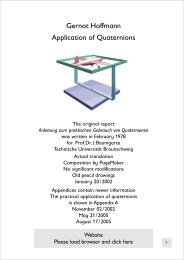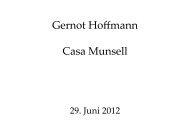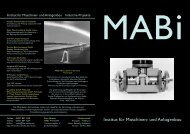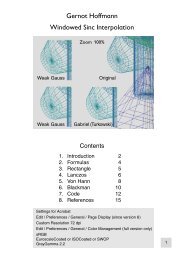Newton's Prism Experiment and Goethe's Objections
Newton's Prism Experiment and Goethe's Objections
Newton's Prism Experiment and Goethe's Objections
Create successful ePaper yourself
Turn your PDF publications into a flip-book with our unique Google optimized e-Paper software.
15. Conclusions<br />
The Conclusions refer to the Introduction, chapter 1. Furtheron some remarks on the perceived<br />
brightness of blue are added.<br />
A [2, Zweiter Teil, Konfession des Verfassers ]<br />
Aber wie verwundert war ich, ...’<br />
A prism refracts a light b<strong>and</strong> or a dense bundle of (fictitious) rays without strong color effects<br />
in the middle because these rays sum up to white light. Goethe was not aware of this superposition.<br />
Therefore he emphasized color effects correctly at the boundary of the bundle.<br />
Newton’s crucial experiments were essentially done with thin rays.<br />
It is not underst<strong>and</strong>able why Goethe did not discuss the case for a thin ray. It seems that he<br />
regarded this as a quite unnatural test condition which had nothing to do with real life.<br />
In fact he did not read Opticks carefully or at all. For example, the ellipse (C) in his drawing<br />
was clearly described by Newton as ‘oblong’, the envelop of a sequence of circles.<br />
B [2, Zweiter Teil, Polemischer Teil ]<br />
’Also, um beim Refraktionsfalle zu verweilen, ...’<br />
Goethe assumes that refraction itself does not create color effects. This would require an<br />
image which is refracted <strong>and</strong> shifted as well, <strong>and</strong> which has boundaries, because it is an<br />
image. But if it is refracted then it is shifted - the argument is not underst<strong>and</strong>able.<br />
On the other h<strong>and</strong> he is right in a certain sense, though without being aware of: refraction<br />
itself does not colorize anything. The color or dispersion is a result of different refraction<br />
indices for different wavelengths, for different spectral colors.<br />
C [2, Zweiter Teil, Beiträge zur Optik ]<br />
’Unter den eigentlichen farbigen Erscheinungen sind nur zwei, ...’<br />
Goethe’s Erste Tafel shows color wheels. He had accepted Newton’s model to a certain extent.<br />
Goethe’s model uses (also according to [7]) three primaries yellow, blue, red <strong>and</strong> three<br />
secondaries orange, violet, green. On the other h<strong>and</strong> he considers only yellow <strong>and</strong> blue as<br />
pure colors. Maybe this was just an unnecessary complication.<br />
Goethe knew almost all the other contributors to color science, as mentioned in the same<br />
book [7], but not yet Philipp Otto Runge, who published 1810 the first threedimensional color<br />
space, a sphere.<br />
The Blue Mystery<br />
In simulations we perceive in the spectrum bars the small part for pure blue on monitors as<br />
too bright. The color reproduction is based on the sRGB model which describes with sufficient<br />
accuracy common cathode ray tube monitors (real monitors are calibrated by instruments, a<br />
process which introduces the actual parameters into the color management system).<br />
The contribution of blue to the luminance is given by equations like this:<br />
L = 0.3R + 0.6G + 0.1B<br />
With accurate numbers this is colorimetrically correct. Is blue really six or seven times darker<br />
than green ? The author could not prove such a ratio by flicker tests.<br />
An explanation might be the Helmholtz-Kohlrausch effect [13] which means: fully saturated<br />
colors appear brighter than less saturated colors. The table in chapter 10 shows the highest<br />
saturations for red at 0.63µm, for green at 0.54µm <strong>and</strong> for blue at 0.47µm.<br />
19


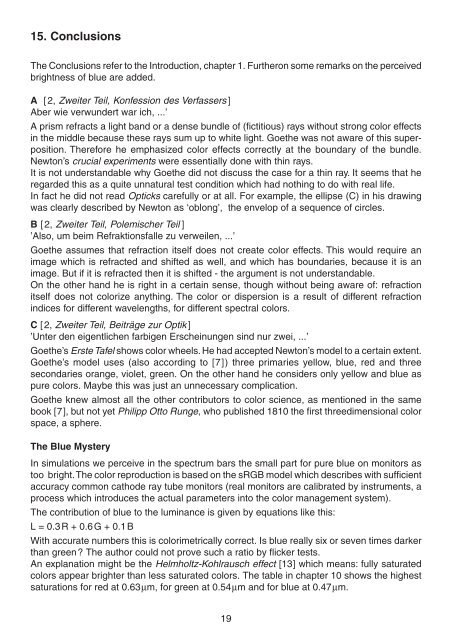
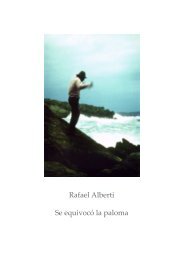


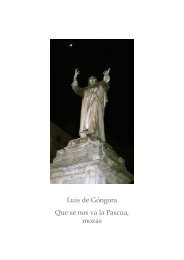
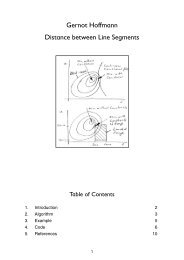

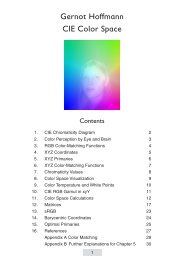
![[PDF] SpieleProgrammierung](https://img.yumpu.com/6860251/1/190x135/pdf-spieleprogrammierung.jpg?quality=85)
